When thinking about birds with long legs, most people automatically think of a bright pink flamingo standing on one leg. This is undoubtedly a spectacular sighting! However, the world is full of many other long-legged birds, including one that’s just as pink and beautiful as a flamingo!
13 Birds with Long Legs
A study shows that birds use their legs for foraging, paddling, propulsive, and grooming purposes. But why do some birds have such long legs?!
As you’ll soon notice, most birds with long legs are inhabitants of aquatic and semi-aquatic environments. Therefore, one of the main reasons their legs have evolved to be so long is to help them walk through water and keep their feathers away from it.
However, some birds take advantage of their long legs and use them for other purposes – some even use their legs to kill prey! Moreover, you’ll also notice that some birds on our list have long, thin toes, too, which are of great help in maintaining their balance and while walking in water.
1. White-Faced Ibis

- Scientific name: Plegadis chihi
- Size: 18.1 – 22.1 inches
- Weight: 15.9 – 18.5 ounces
The white-faced ibis is typically brownish with green-yellowish shades. It has a pink face outlined by white feathers and bright red legs during the breeding season. The bird is often mistaken for the glossy ibis.
These distinguishable birds are common in the United States and Canada, as well as in Central America and the southern part of the South American continent.
In North America, some birds migrate from north to south for the winter – those breeding in southern Oregon or northern California travel to Mexico and southern California, respectively, to reach the wintering grounds. However, migration between the two continents is uncommon.
Their natural habitats include marshes with dense vegetation, where white-faced ibises prefer building their nests – primarily in bushes or low trees. The eggs of these beautiful birds have a unique blueish-green color.
Their lifespan is an addition to their uniqueness, as the oldest wild white-faced ibis set a record of reaching a lifespan of 14 years and six months!
2. Great Blue Heron

- Scientific name: Ardea herodias
- Size: 36 – 54 inches
- Weight: 4 – 7.9 pounds
A great blue heron is usually gray with shades of azure blue and features red-brownish thighs, a rusty gray neck contrasting with black and white, and a paler head with a white face.
These birds are endemic to North and Central America, the Galapagos Islands, and the Caribbean Islands. They are migratory and inhabit the northern parts of the North American continent during the breeding season – from the southern Canadian provinces all the way north to Alaska.
During the winter, these long-legged birds migrate south to Florida, Mexico, the Caribbean, and as far as northwestern South America. However, some populations are year-round residents – these are usually inhabitants of the southern part of the continent.
These highly adaptable birds are found in almost any wetlands – mangrove swamps, fresh and saltwater marshes, lake edges, and shorelines, to name a few.
Their breeding season starts as early as December in warmer climates. Great blue herons usually breed in colonies consisting of 5 – 500 nests, and their breeding grounds bear the name of heronries.
These birds are skilled predators and can catch fish as large as 24 inches and weighing as much as 2 pounds!
3. Flamingo
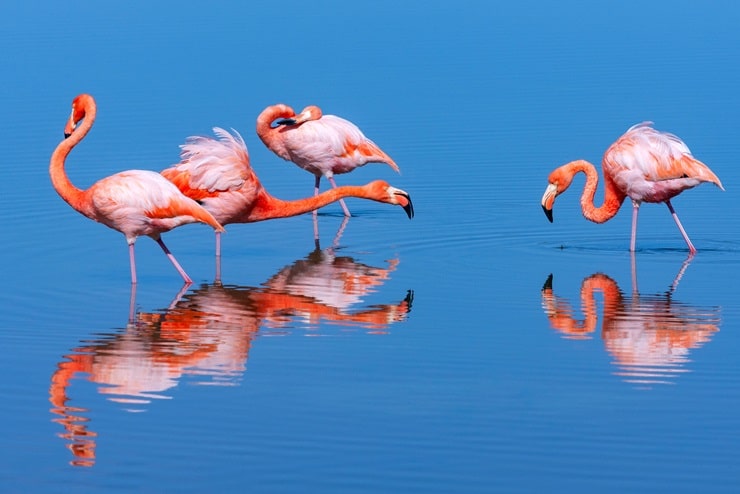
- Scientific name: Phoenicopteridae (family)
- Height: 2.6 – 4.7 feet tall
- Weight: 5.5 – 7.7 pounds
- Leg length: 31.5 – 49 inches
You’re probably already familiar with the famous long-legged, pink flamingoes often spotted standing on one leg! However, despite popular belief, not all flamingoes are pink – some can be bright red or have paler shades. The plumage color highly depends on how nutritious the bird’s diet is – the more nutritious, the brighter the plumage.
The distribution of these birds varies depending on the six species. Generally speaking, they’re found in Africa, Eurasia, South America, and North America. In their natural range, flamingoes are common in wetlands like lagoons and shallow, brackish inland or coastal lakes. They’re typically considered short-distance migratory birds that often change their homes if food sources are scarce or the habitat is disturbed.
During the breeding season, these unique pinkish birds live in colonies split into breeding groups. These groups usually consist of 15 – 50 male and female birds that exhibit a distinguishable ritual display by stretching their necks, flapping their wings, and performing specific calls.
4. Least Bittern
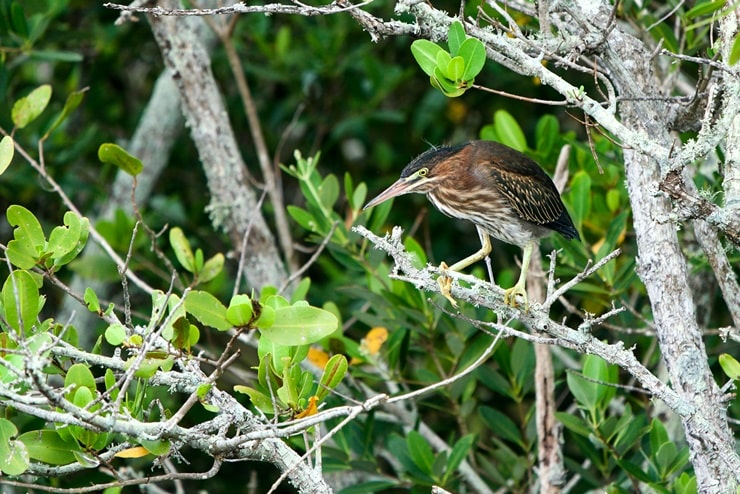
- Scientific name: Ixobrychus exilis
- Size: 11 – 14 inches
- Weight: 1.8 – 3.6 ounces
Least bitterns are relatively small birds (compared to others on our list) which enrich nature with their distinctive plumage – white with brown streaks on the throat and underparts, light brown faces and sides of the neck, yellow bills and eyes, and yellow-greenish legs.
Spotting these birds shouldn’t be challenging as long as you visit their breeding and wintering grounds. They typically breed in southeastern Canada, the eastern-central United States, Mexico, and some parts of Central America. Least bitterns build nests in large marshes that feature dense vegetation. When the temperatures drop, these beautiful birds can be spotted traveling south. The populations living in South America are year-round residents.
However, since the population numbers have somewhat dropped, you may equip yourself with patience while trying to spot these birds, as many people reported that seeing them is pretty uncommon – hearing them, on the other hand, isn’t as rare.
5. Jabiru

- Scientific name: Jabiru mycteria
- Size: 47 – 55 inches
- Weight: 9.5 – 19.8 pounds
The jabiru is a stork bird in the Ciconiidae family. It’s one of the birds exhibiting a strong sexual dimorphism in terms of size – females are around 25% smaller than males. However, they are similar in terms of plumage color – both are primarily white.
These birds are common in Central and South America, although some were spotted in the United States, too. Since jabirus feed on aquatic or semi-aquatic species, they prefer inhabiting wetlands. Therefore, they’re most often spotted near ponds or rivers. These wading birds are generally non-migratory but may sometimes change their feeding grounds.
Jabirus are solitary birds and are believed to form lifelong bonds with their partners. During the breeding season, these storks build large nests they often use for several seasons. Both male and female birds participate in incubating the eggs and then take care of their young for around six months before they leave. This is why the pairs often cannot breed in successive seasons. However, since jabirus have a lifespan of 36 years, there’s more than enough time for them to maintain their population steady!
6. Purple Gallinule

- Scientific name: Porphyrio martinicus
- Size: 10 – 15 inches
- Weight: 5 – 10.8 ounces
This is by far one of the most beautiful birds on our list! The purple gallinule, often called the yellow-legged gallinule, has purple-blue plumage that becomes green or turquoise under bright light, a red-yellow bill, and long yellow legs equipped with long toes.
If you want to spot one of these beauties, you should visit the southeastern United States, Mexico, Central America, and the Caribbean. The birds breeding in the United States travel to Central and South America to reach their wintering grounds. However, if you’re lucky enough, you can spot a purple gallinule far away from its natural range, as the species is considered highly vagrant – they’ve been spotted in Iceland, Labrador, Great Britain, and Portugal.
Considering that purple gallinules are ground feeders, they prefer dense freshwater wetlands. Another thing worth mentioning about these yellow-legged birds is that they build floating nests on dense vegetation.
7. Wood Stork
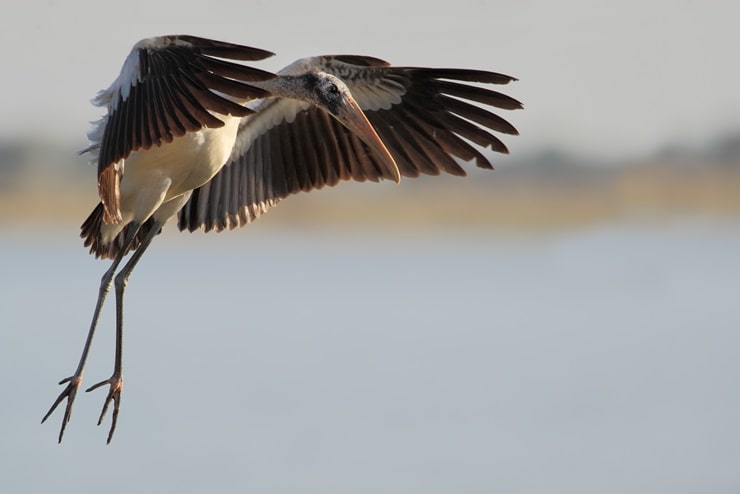
- Scientific name: Mycteria americana
- Size: 33 – 45 inches tall
- Weight: 4.4 – 7.3 pounds
Wood storks are undoubtedly among the world’s most distinctive birds! They’re primarily white but exhibit dark legs, pinkish toes, and black bills and tails (the latter getting a greenish or purplish shade at times).
These wading birds inhabit the tropical and subtropical areas of Central and South America and are the only stork species breeding on the North American continent. If you’re planning to spot one of them during the breeding season in the United States, we recommend traveling to North or South Carolina, Florida, and Georgia, where they’re found in wetlands environments. Although they aren’t officially considered a migratory species, wood storks often move to different grounds within their range.
During the breeding season, wood storks nest in colonies of up to 25 nests built in large trees. These nests are built by males – another distinguishable feature of the species, as the females are responsible for this when it comes to many other bird species.
8. Roseate Spoonbill
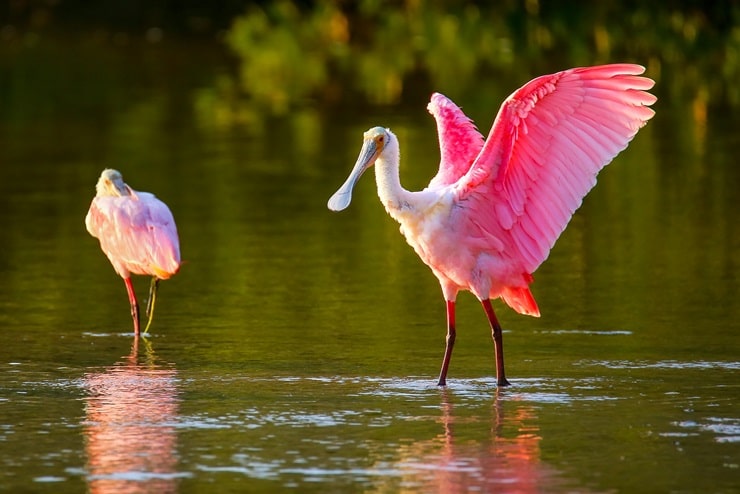
- Scientific name: Platalea ajaja
- Size: 28 – 34 inches
- Weight: 2.6 – 4 pounds
At first, roseate spoonbills may look like flamingoes, thanks to their beautiful, bright pink color. However, you can distinguish the two by the former’s greenish heads and white necks, breasts, and backs.
Spotting them shouldn’t be an issue as long as you visit their natural range – in the United States, they are common in Florida, Texas, and southwestern Louisiana; it is a common species in the Caribbean Islands, Central and South America, Mexico, and the U.S. Gulf Coast. Although their population almost went extinct in the past, they’re now listed as Least Concern, and their numbers are constantly increasing.
Look for these pink, long-legged birds near shallow fresh or coastal waters, as these are their preferred feeding grounds. During the breeding season, you might spot roseate spoonbill nests in trees, shrubs, or mangroves.
9. Sandhill Crane
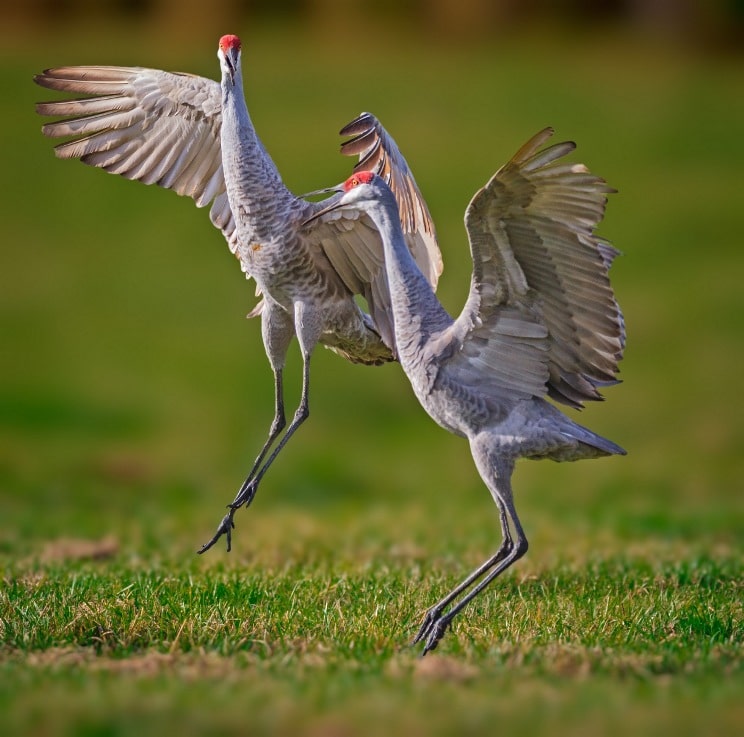
- Scientific name: Antigone canadensis
- Size: 2.6 – 4.4 feet tall
- Weight: 6 – 14.8 pounds
Sandhill cranes are long-necked, long-legged birds exhibiting brown-orangish plumage, a large red spot on the forehead, dark bills, and white cheeks.
Their distribution varies across the subspecies, but the birds are generally found in North America and some parts of northeastern Asia. Their preferred habitats include the American Great Plains, the Platte River, and Nebraska’s Sandhills.
They are typically migratory birds and fly south to reach their wintering grounds. However, there are some non-migratory populations that do not leave their breeding grounds.
The latter lay eggs starting as early as December, while the migratory populations lay eggs in April or May. They’re social birds and are often spotted in groups of thousands of specimens!
Did you know that sandhill cranes are among the world’s oldest birds in terms of fossil records? It is believed that a fossil dating 10 million years ago discovered in Nebraska belonged to a sandhill crane!
10. Secretarybird
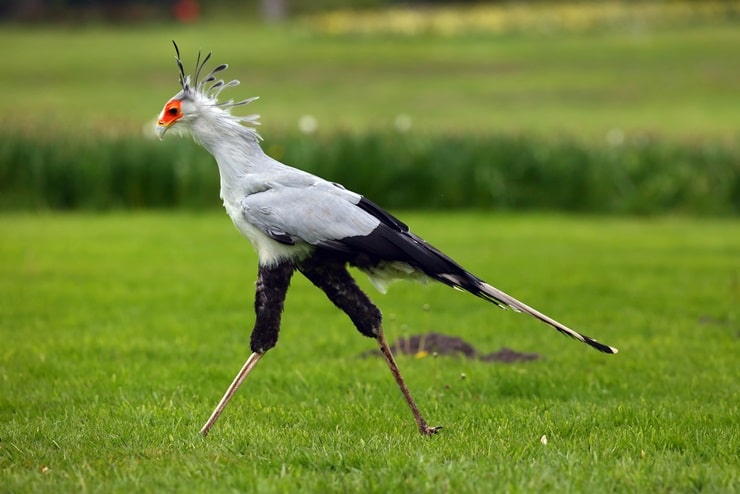
- Scientific name: Sagittarius serpentarius
- Size: 4.2 feet tall; 3.6 – 4.9 feet long
- Weight: 8.2 – 9.4 pounds
The secretarybird is another gorgeous long-legged bird on our list! Its plumage is a combination between blue-gray and light gray. It has crane-like legs, while the head and the body resemble those of an eagle.
Unfortunately, these birds live only in sub-Saharan Africa – your only chance of observing one is by visiting the African continent. Secretarybirds are found from Senegal to Somalia, their range extending to South Africa, Western Cape specifically.
Their natural habitats include savannahs, grasslands, and shrublands. Generally speaking, these birds of prey aren’t migratory, although some may move to a different region within their range. This depends on weather conditions and food availability.
In terms of breeding, secretarybirds are monogamous and solitary and can breed whenever they want. However, they’ve been observed to prefer the late dry season as a breeding season.
Here’s something you probably didn’t know about secretarybirds – they use their legs to kill prey! Adult male birds are known to be able to hit with a force five times their body weight!
11. Black-Necked Stilt
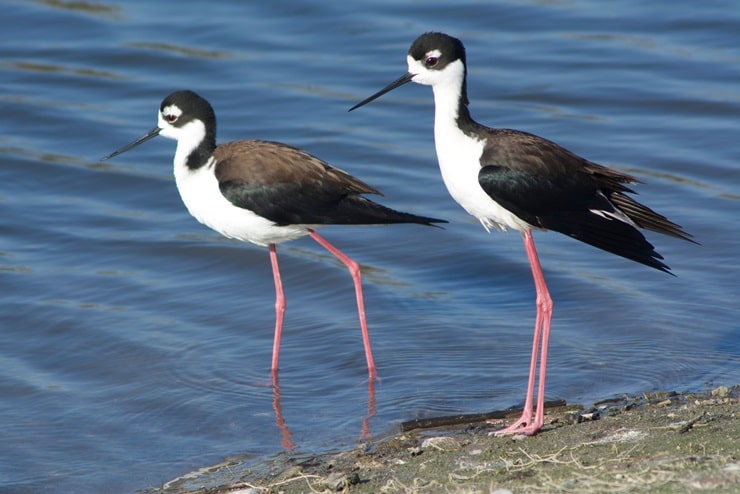
- Scientific name: Himantopus mexicanus
- Size: 13.8 – 15.3 inches
- Weight: 5.3 – 6.2 ounces
Another long-legged bird on this list is the abundant shorebird called the black-necked stilt. It has white underparts, black wings and upper parts, a white tail, pink legs, and a black bill.
These birds prefer inhabiting estuarine, salt pond, and lacustrine environments.
They’re fairly common in North, Central, and South America, being abundant in the San Joaquin Valley, which serves as a wintering ground.
Northern populations migrate from July to September and fly back north from March to May.
The breeding season usually starts in April and lasts through August, although this depends on the geographic distribution.
Black-necked stilts build their nests around 65 feet from other birds’ nests and are considered semi-colonial birds.
Here’s a fun fact – their young develop so fast that they can swim two hours after hatching! However, the parents take care of them for several weeks before they become fully independent.
12. Limpkin
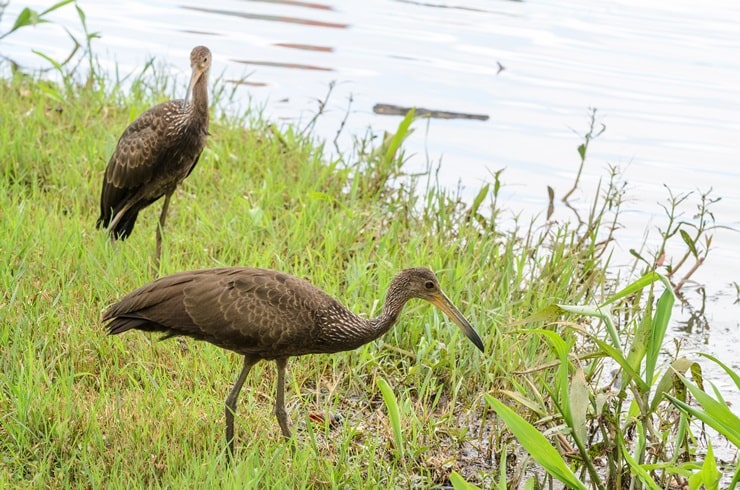
- Scientific name: Aramus guarauna
- Size: 25 – 29 inches
- Weight: 2 – 2.9 pounds
The limpkin is a large wading bird featuring beautiful brownish plumage with distinctive white spots.
It is widely distributed in Central and South America, although some populations are found in peninsular Florida, southern Georgia, and southern Mexico. On the South American continent, the species is primarily found east of the Andean Mountain Range.
Since they’re wading birds, limpkins live in aquatic habitats – freshwater swamps and marshes, as well as mangroves. However, some populations have established their “homes” in dry brushlands.
They are considered short-distance migratory birds, although scientists haven’t yet fully confirmed why they perform these migratory acts.
During the breeding season, limpkins are extremely territorial, and males actively engage in territorial defense.
Did you know that the limpkin’s call was used as a hippogriff call in “Harry Potter and the Prisoner of Azkaban?”
13. Cattle Egret
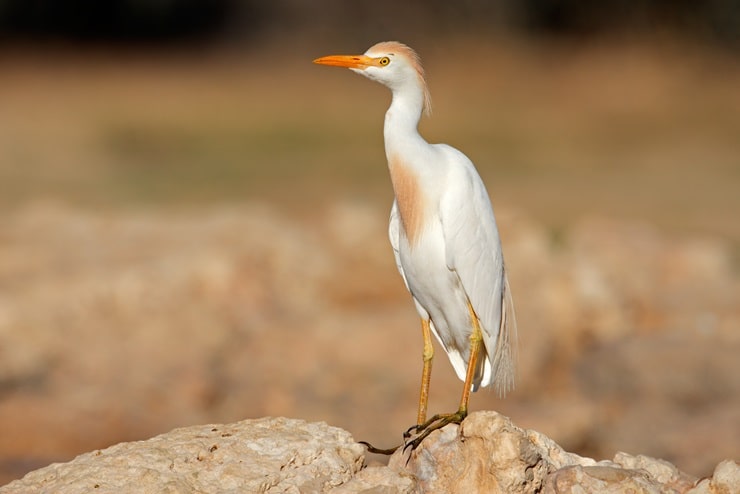
- Scientific name: Bubulcus ibis
- Size: 18 – 22 inches
- Weight: 9.5 – 18 ounces
The cattle egret is a white bird with a yellow bill and gray-yellowish legs. During the breeding season, however, some specimens feature orange buff plumes that turn red shortly before pairing.
They are native to Africa, Asia, and Europe, but today they’re distributed worldwide. Their natural habitat includes fields and dry grassy areas, where cattle egrets can easily feed on terrestrial insects. Some birds prefer feeding in shallow water, too.
Cattle egrets are typically considered migratory birds, although not all populations leave their breeding grounds. Moreover, some can be both migratory and sedentary.
Since they have a worldwide distribution, their migratory patterns strongly depend on where they breed. For example, those nesting in Australia leave for Tasmania or New Zealand during the winter.
Cattle egrets’ nesting grounds are typically near bodies of water. Their nests are formed in colonies and are sometimes shared with other birds like ibises or herons.
Did you know that the estimated global cattle egret population is 3.8 – 6.7 million individuals?!
